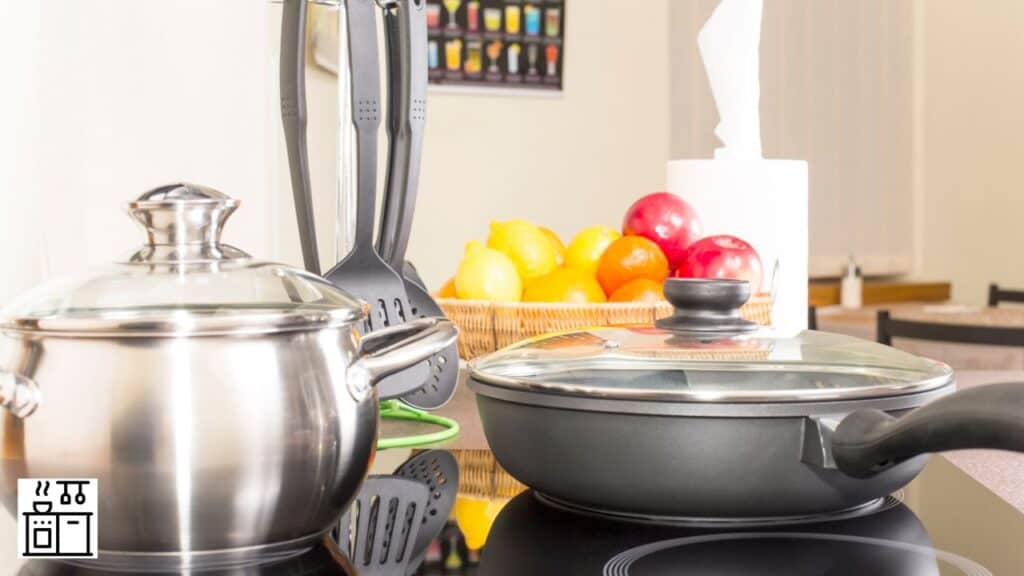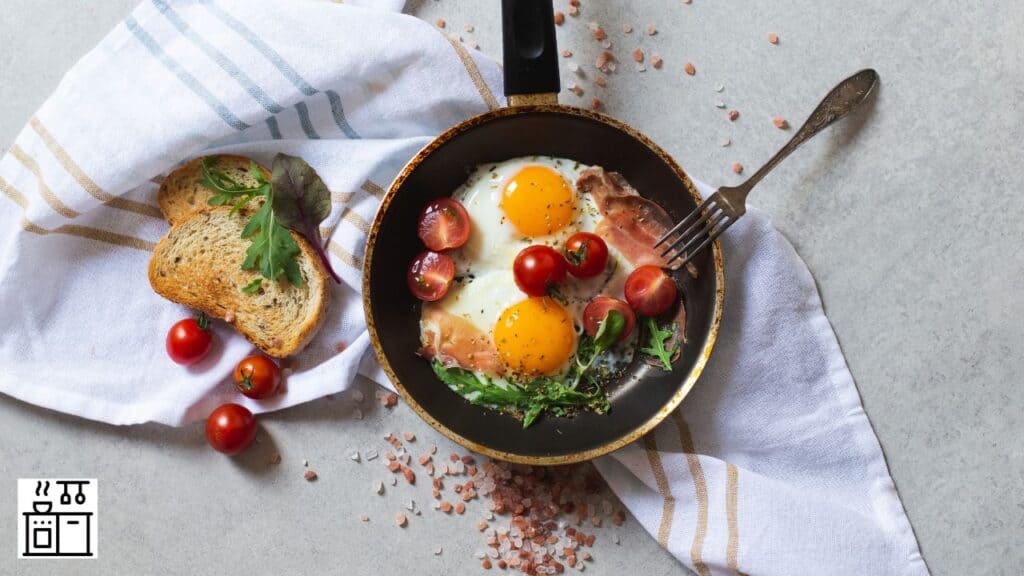Ceramic pans are popular for various reasons, including their non-stick properties, iconic colors, durability, and ease of maintenance.
These pans are generally used for stovetop cooking. But ceramic as a material is generally heat resistant.
So, can ceramic pans go in the oven?
Is It Safe to Use Ceramic Pans in The Oven?
Most ceramic pans can safely go in the oven. However, there are exceptions based on the construction method used.
Since oven temperatures are very high, the capacity of a ceramic pan to withstand heat would depend on the type of pan.
100% ceramic pans are generally oven-safe because they can withstand extremely high temperatures. Pans with a metal base layered with ceramic coating can’t tolerate the extremely high temperatures of an oven.
Factors to Consider Before Placing a Ceramic Pan in The Oven
Let’s now look at some important factors that will help you decide if a ceramic pan can go in the oven or not.
1. Type of Ceramic Pan
We can broadly classify ceramic pans into two types. The first type of pan is entirely made of ceramic.
The other one, which is more commonly available, has a metal base with layers of ceramic coating the base layer.
This difference in construction decides the ability of a ceramic pan to withstand heat.
Cookware made of 100% ceramic can easily go in the oven. Pure ceramic can withstand extreme temperatures, as high as 2500°F. So you can safely use it in the oven.
Ceramic pans with a metal base and ceramic coating are also heat-resistant. Most of them can go in the oven.
They can usually tolerate temperatures between 500°F and 600°F. We don’t recommend exceeding this temperature range.
2. Material Used for The Handle
While the base of a ceramic pan will usually be oven-safe, we can’t say the same for the handle.
So you should consider this factor when you place a ceramic pan in the oven.
The handles of most ceramic pans are made of heat-resistant materials. However, there are exceptions.
If the handle is made of plastic, phenolic resin, or bakelite, it can’t tolerate temperatures above 350°F.
Since oven temperatures can exceed this range, we don’t recommend placing such pans in the oven.
Stainless steel handles are more temperature resistant. You can safely use them at temperatures as high as 500°F.
3. Instructions from The Manufacturer
The best way to determine if a ceramic pan is oven-safe is to check the manufacturer’s instructions.
The label will indicate whether you can safely place the pan in the oven.
Sometimes, an oven-safe symbol may be present on the package. This is represented as a temperature displayed inside a square box.
The same symbol will also be present on the base of the pan if it’s oven-safe.
Alternatively, you may find some numbers written on the bottom of the ceramic pan. This usually indicates the maximum temperature that the pan can withstand.
Some brands just list “oven-safe” on the label instead of using a symbol or numbers.
In this case, the pan is usually safe to use at high oven temperatures as well.
How to Safely Use Ceramic Pans in The Oven?
The factors we previously discussed will help you determine if a particular ceramic pan is safe to use in the oven.
Let’s also look at a few pointers to ensure these pans are safe for oven use.
1. Coat the Surface with A Thin Layer of Oil or Cooking Spray
You don’t need to use much oil when using a ceramic pan. These pans also don’t need any pre-seasoning.
Nevertheless, you can coat the surface with a thin layer of oil before putting the dish in the oven.
This will ensure that the food doesn’t stick to the surface. It will also make cleaning up easier.
2. Avoid Using Metal Utensils
Ceramic surfaces aren’t as delicate as Teflon. Nevertheless, we don’t recommend using metal utensils to stir or mix ingredients.
The sharp and rough edges of these utensils can speed up the deterioration process in the long run, making the pan lose its non-stick properties.
Scraping the surface roughly can also make the ceramic coating chip away, making it uneven over time.
Further Reading: 7 Main Differences Between Ceramic and Teflon Pans
3. Use at Medium Heat

Ceramic pans are best used at medium heat. Though they can withstand high temperatures, it’s best to avoid high heat use to prolong their lifespan.
You can use these pans for baking and warming, but we don’t recommend them for grilling and broiling.
4. Handwash After Use
Ceramic pans should be washed by hand and not put in the dishwasher to make them last longer.
They are not too difficult to clean. So even if there are stubborn stains, you can soak the pan to dislodge the food residue.
Once the food is released from the surface, gently wipe the pan to clean it thoroughly.
5. Transfer Food Immediately to Avoid Staining
Ceramic pans don’t react with most food ingredients.
However, the light surface can develop stains and discoloration when the dish contains tomatoes or beets, and you leave them in for too long.
It’s nearly impossible to remove such stains once they set in.
To prevent this from happening, transfer food immediately from the pan after cooking to prevent the pan from getting discolored.
Benefits of Baking with Ceramic Pans
Once you find a ceramic pan that is safe for baking, there are various things you can use it for.
It also offers several advantages over other types of cookware. Let’s find out what they are.
1. Toxin-Free
Many pans used in the oven have a non-stick coating. This coating is not sturdy and it can peel off easily. When it does, it presents various health risks.
One of the biggest benefits of using ceramic pans for baking or grilling is the safety aspect. The coating of these pans is inert.
It doesn’t release any toxins or fumes even when heated. So you can safely use it at high temperatures without worrying about unwanted side effects.
2. Non-Reactive
Some construction materials like cast iron and carbon steel react with certain ingredients during cooking.
For instance, iron reacts with acidic ingredients like tomatoes and vinegar if you leave them in for too long.
It can affect the appearance of the pan and the color of the cooked food.
Ceramic pans are free from such problems. The coating is non-reactive, and it’s not affected in any way when you cook different ingredients in it.
So you can safely use ceramic pans to cook acidic food like tomatoes or vinegar-based sauces.
Neither the taste and color nor will the quality of the dish be affected.
3. Supports Healthier Cooking
Another advantage of using ceramic pans for cooking is they reduce the need for oil and butter.
Since the surface of the pan is non-stick, food easily glides off.
So you will not need much oil or butter to cook a dish and still prepare it well. It’s thus suitable for healthier recipes that use minimal to no oil for cooking.
4. Easy to Clean
Ceramic pans are easy to clean. The non-sticky surface prevents food from attaching.
It’s also easy to scrub or wipe off food residue from the surface.
In the rare case that there are stubborn food residues, you can soak the pan in warm soapy water for a short while.
Once the food softens, wipe or scrub it off without any abrasive cleaners.
Further Reading: 8 Pros and 6 Cons of Ceramic Pans
5. Durability
Ceramic pans are advantageous over Teflon pans because of their long lifespan.
Ceramic pan surfaces are sturdier, and the surface doesn’t erode quickly. Nor does the surface coating come off easily.
So these pans last for several years. This factor makes it worth the investment.

